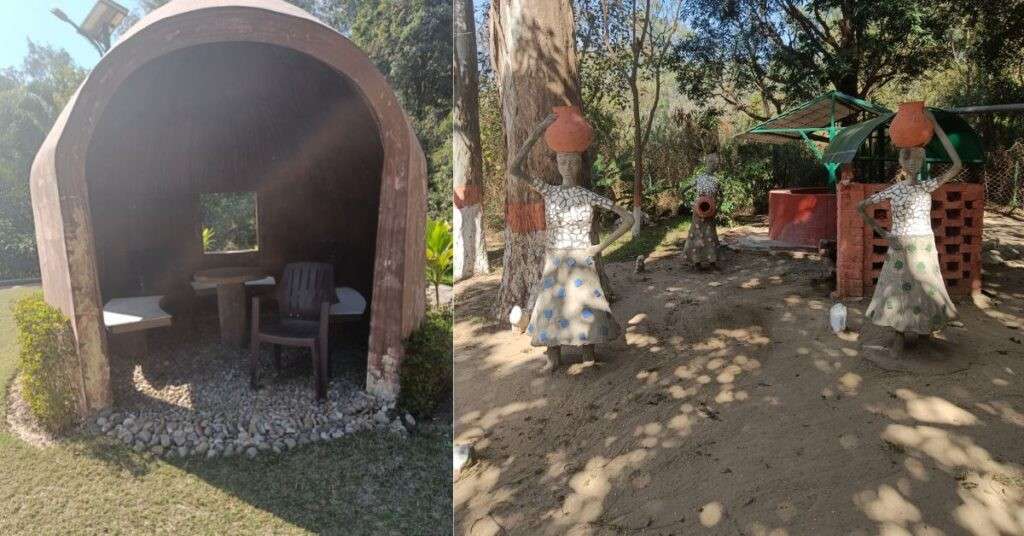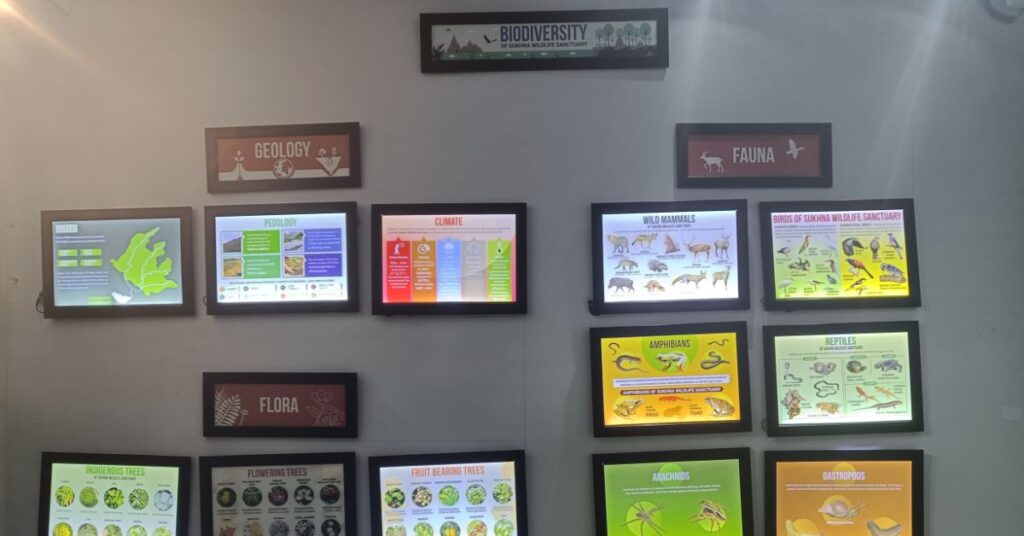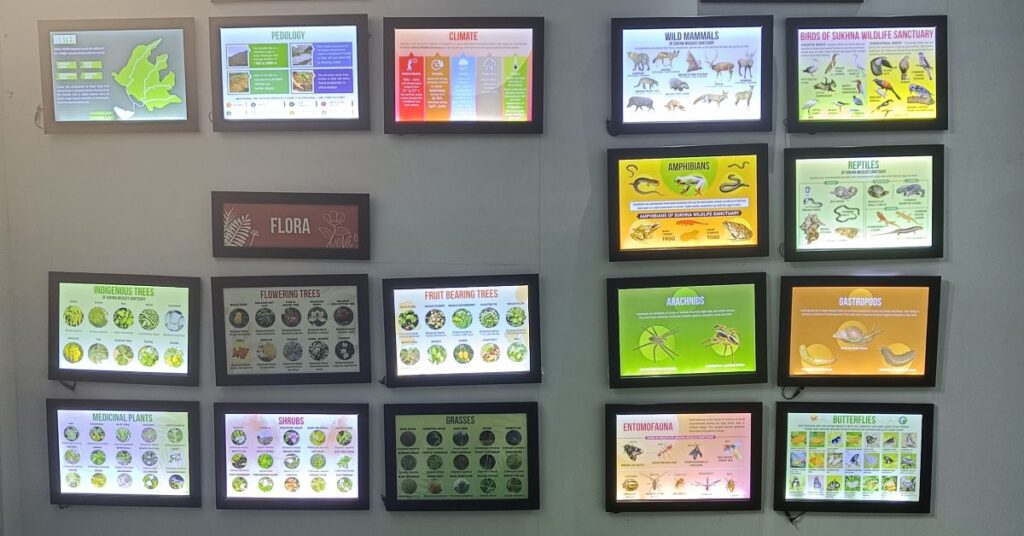Sukhna Wildlife Sanctuary is a 2600-hectare reserve located in the Shivalik foothills near Sukhna lake in Chandigarh. This wildlife sanctuary was created from reserved forests to protect, propagate and develop the wildlife and their environment.
The sanctuary is home to a diverse range of flora and fauna, including mammals such as sambar, chital, wild boar, porcupine, hare, rhesus macaque, hanuman langur, and fire-striped palm squirrel. The only large cat found in the sanctuary is the leopard, while other carnivores include jackal, small Indian civet, jungle cat, porcupine, common mongoose, common rat, and squirrel.
Reptiles such as the Indian cobra, rat snake, common krait, Russell’s viper, and Indian python can also be found in the sanctuary. Two types of tortoises and three to four types of lizards are also present, including one species with brilliant vermilion color during the mating season.
The forest of Sukhna WLS is rich in birdlife, including species like a peacock, red-vented fowl, grey partridge, cuckoos, night jars, golden oriole, kingfishers, swifts, hoopoes, hornbills, woodpeckers, rollers, barn owls, parrots, doves, jacanas, plovers, coots, hawks, geese, swan, ducks, grebes, black drongo, tree pie, jungle crow, bulbul, hill myna, koel, bee-eater, and common myna. At least five species of birds, primarily found in grasslands and aquatic habitats, have been listed in the IUCN Red List of globally threatened animals.
The best time to visit Sukhna Wildlife Sanctuary is between October and March. The sanctuary is open from 10 AM to 5 PM in both winter and summer but is closed during the monsoon season from 1st July to 20th August.

Sukhna Wildlife Sanctuary is located in Chandigarh, India, and can be reached by various modes of transportation:
By Air: The nearest airport is Chandigarh International Airport, located about 18 km from the sanctuary.
By Train: The nearest railway station is Chandigarh Railway Station, located about 8 km from the sanctuary.
By Bus: Regular buses run from Chandigarh to the sanctuary.
By Car: The sanctuary is located about 2 km from Sukhna Lake and is well-connected by road. Visitors can hire a taxi or drive to the sanctuary.
It is recommended to carry a map and check the weather conditions before visiting the sanctuary as the road conditions may be affected during the rainy season.




Citizens can help keep Sukhna Wildlife Sanctuary in Chandigarh clean and safe by following these simple steps:
Proper disposal of waste – Citizens must make sure to properly dispose of their waste and not litter the sanctuary
Avoid the use of plastic – plastic waste can harm wildlife and the environment, citizens should bring reusable containers and avoid the use of single-use plastic
Respect wildlife – visitors should not disturb the wildlife and should keep a safe distance from them
Support conservation efforts – citizens can support conservation efforts by donating to organizations working towards wildlife preservation and supporting eco-friendly initiatives
Be a responsible visitor – visitors should follow the rules and regulations of the sanctuary, avoid loud noise and keep the sanctuary clean
Report any incidents – citizens should report any incidents of poaching, poaching, or illegal activities to the authorities for prompt action.
By following these steps, citizens can play a crucial role in keeping the Sukhna Wildlife Sanctuary clean and safe, thus preserving the biodiversity and preserving it for future generations.


Tourists visiting Sukhna Wildlife Sanctuary in Chandigarh can help keep the area clean and safe by following these steps:
Littering: Do not litter in the sanctuary and dispose of waste properly in designated bins.
Respect Wildlife: Observe wildlife from a safe distance and do not interfere with their natural habitats or behaviors.
Stay on trails: Stick to designated walking trails and do not go off-path to avoid damaging the natural environment.
Avoid disturbing the peace: Do not make loud noises or play music that may disturb the wildlife or other visitors.
Respect rules and regulations: Follow all rules and regulations set by the sanctuary authorities to ensure the safety of both visitors and wildlife.
Support conservation efforts: Consider supporting conservation efforts by purchasing souvenirs from sanctuary gift shops or making a donation to support wildlife conservation.
Spread the word: Encourage others to visit Sukhna Wildlife Sanctuary and to follow these guidelines to keep the area clean and safe.
Sukhna Wildlife Sanctuary is a wildlife sanctuary located in the Shivalik foothills of Chandigarh city near Sukhna lake and spreads over 2600 hectares of land.
The Sukhna Wildlife Sanctuary harbors a wide range of faunal biodiversity including mammals like Sambar, Chital, Wild boar, Porcupine, Hare, Rhesus macaque, Hanuman Langur, etc. and carnivores like Leopard, Jackal, Small Indian Civet, Jungle Cat, Porcupine, Common-Mongoose, etc.
The sanctuary houses various types of reptiles like Indian Cobra, Rat Snake, Common Krait, Russell‟s viper, Indian Python, Common Monitor Lizard, and 3-4 types of lizards.
The Sukhna Wildlife Sanctuary is rich in avifauna and is home to various bird species like Peacock, Red vented fowl, Grey Partridge, Cuckoos, Night jars, Golden Oriole, Kingfishers, Swifts, Hoopoes, Hornbills, Barbets, Woodpeckers, Rollers, Barn owls, Parrots, Doves, Jacanas, Plovers, Coots, Hawks, Geese, Swan, Ducks, Grebes, Black Drongo, Tree pie, Jungle crow, Bulbul, hill myna, Koel, Bee-eater, and Common Myna.
Winter Timings: 10 AM – 5 PM, Summer Timings: 10 AM – 5 PM. The sanctuary is closed during monsoon season (1st July to 20th August). The best time to visit is between October and March.
Yes, there are various amenities available for tourists visiting the sanctuary such as restrooms, picnic areas, and watchtowers for bird watching.
Yes, there is an entry fee for visiting the sanctuary. The fee may vary depending on the time of the year and the number of people visiting.
Yes, photography is allowed in the sanctuary but with certain restrictions. Tourists are advised to check with the authorities before clicking photographs.
Yes, it is safe to visit Sukhna Wildlife Sanctuary. The authorities have made necessary arrangements for the safety of tourists and the wildlife. Tourists are advised to follow the rules and regulations set by the authorities to ensure the safety of both themselves and the wildlife.
Chandigarh is the capital of the Indian states of Punjab and Haryana, and it is also a union territory in its own right. Located in the northwest of the country, Chandigarh is known for its modernist architecture and urban planning, which was designed by the French architect Le Corbusier in the 1950s.